Nielsen Department Store Sales Effect Study: AM/FM Radio Campaign Grows Sales +10%, Increases Customer Base +17%, And Expands Share Of Category Spend +15%
Click here to view an 11-minute video of the key findings.
Over the years, Nielsen has conducted dozens of sales effect studies quantifying AM/FM radio’s ability to generate strong sales growth and return on advertising spend. But in 2021, a new question arose. One year into the pandemic, would AM/FM radio still generate impressive sales effect for retailers?
In Spring 2021, a national department store ran an AM/FM radio campaign. The Cumulus Media | Westwood One Audio Active Group®, in a historic new post-COVID study, examined the sales lift of the entire AM/FM radio campaign that included every single AM/FM radio ad run by the retailer.
The Cumulus Media | Westwood One Audio Active Group® commissioned a Nielsen sales effect study. Nielsen matched Portable People Meter panel commercial audience exposures with credit and debit purchase data to reveal how AM/FM radio impacted sales for the major national department store retailer. Nielsen’s analysis examined the campaign that ran from April 19, 2021 through July 31, 2021, comparing those who were exposed and unexposed to determine ad effectiveness.
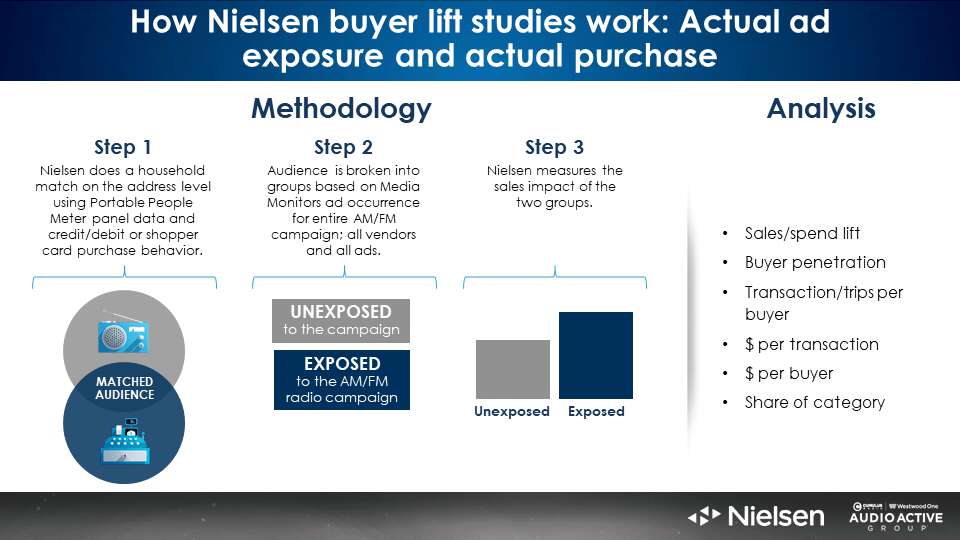
Actual ad exposure + actual customer spend = actual sales effect and ROI
Using Nielsen’s Portable People Meter panel of 80,000 respondents, campaign exposure was measured at the individual person level, not just at the household level.
Commercial audience exposure was matched to actual spend using credit and debit card spending from the home address associated with PPM advertising exposure.
Imagine 32 Main Street in Eastchester, NY is a Nielsen Portable People Meter home. Debit and credit card spending from that household address is matched to the individual person’s AM/FM radio commercial exposure to the retailer’s ads. So actual commercial exposure is matched to actual spend at the retailer from the same household.
The study was conducted among 32,463 Portable People Meter panelists in Nielsen’s 48 PPM markets who were the national department store chain’s customers. 15,020 were unexposed to the AM/FM radio campaign and 17,443 were exposed to the campaign. During the three-month campaign, 58% of all Americans were reached by the national AM/FM radio campaign.
Why “real” ROI studies are better than media mix modeling
It is not uncommon for brands to report that AM/FM radio does not perform well in media mix modeling studies. AM/FM radio is such a small part of many national brand media investments that the media mix model has a hard time generating a stable and reliable read.
Media mix modeling is a self-fulfilling prophecy. It reads well for the largest media investments in the plan. The small elements in the media plan experience “performance bounce” in sales volume and return on marketing investment metrics.
A far more effective and meaningful approach is to conduct “real” sales effect and return on ad spend studies with Nielsen. Actual media exposure is connected to actual consumer spend to generate actual sales effect and ROI.
Here are the key findings from the Nielsen study:
Total campaign sales increases were driven by a +17% increase in customer growth
What is more important: increasing sales from existing customers or growing an advertiser’s customer base? A vast array of marketing effectiveness experts come down decisively on the side of growing the customer base, also known as household buyer penetration.
Byron Sharp, the author of the marketing bestseller How Brands Grow: What Marketers Don’t Know, says growth “never occurs without the brand increasing the size of its customer base (market penetration), and that requires building mental and physical availability.”
Les Binet, Head of Effectiveness at adam&eveDDB, and Peter Field, Marketing Consultant and one of the foremost experts of advertising effectiveness, wrote the highly respected book, The Long and the Short of It: Balancing Short and Long-Term Marketing Strategies. Binet and Field are known as the “godfathers of marketing effectiveness.”
Binet and Field studied hundreds of campaigns and sales results. Their conclusions:
- Targeting existing customers delivers smaller profits and more short-term sales response
- The longer the time frame, the more important new customers are to profitability
- The benefits of broad reach considerably outweigh the benefits of tight targeting
Light exposure to the campaign generated an eye popping +22% increase in the retailer’s customer base
Those who were only exposed one or two times across the three-month period generated an impressive +22.4% increase in the retailer’s customer base. Campaign exposure of three to six times resulted in a +7.6% customer base increase. Those reached seven or more times saw customer base growth of +17.8%.
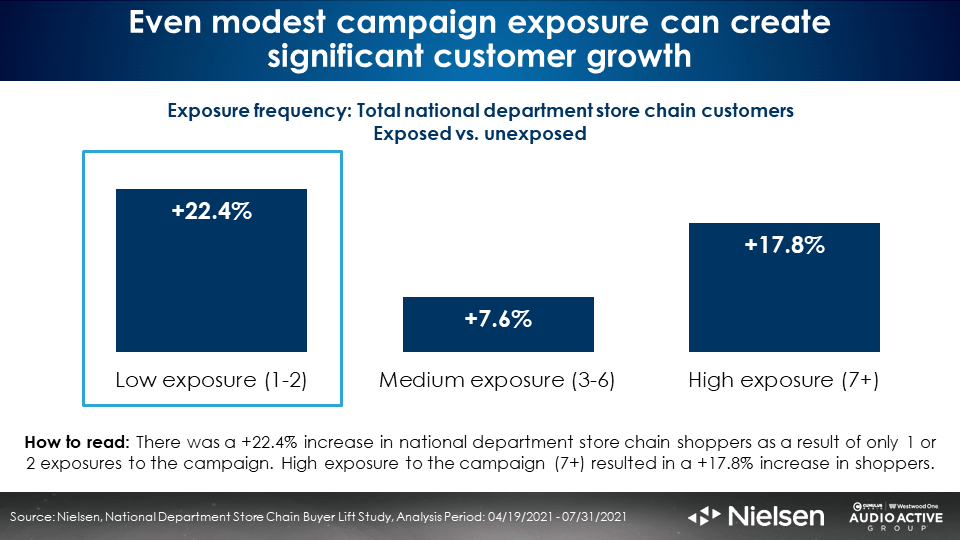
Different seasonal messages delivered strong lifts in customer base and total sales growth
Nielsen can match consumer exposure to specific creative and quantify the sales effect of each campaign. Across the three-month period, the department store ran five seasonal campaigns. “Creative B” grew the department store customer base by +23.6% and increased sales +31.4%.
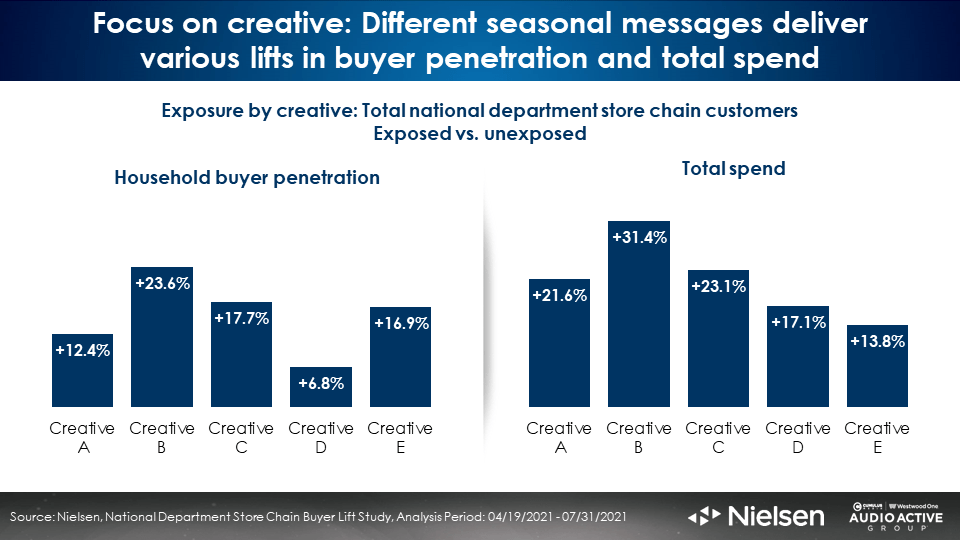
Exposure to the AM/FM radio campaign drove significant lifts in buying transactions, especially among heavy shoppers
The number of transactions per buying household grew +11% among existing customers of the national retailer and a stunning +31% among heavy shoppers.
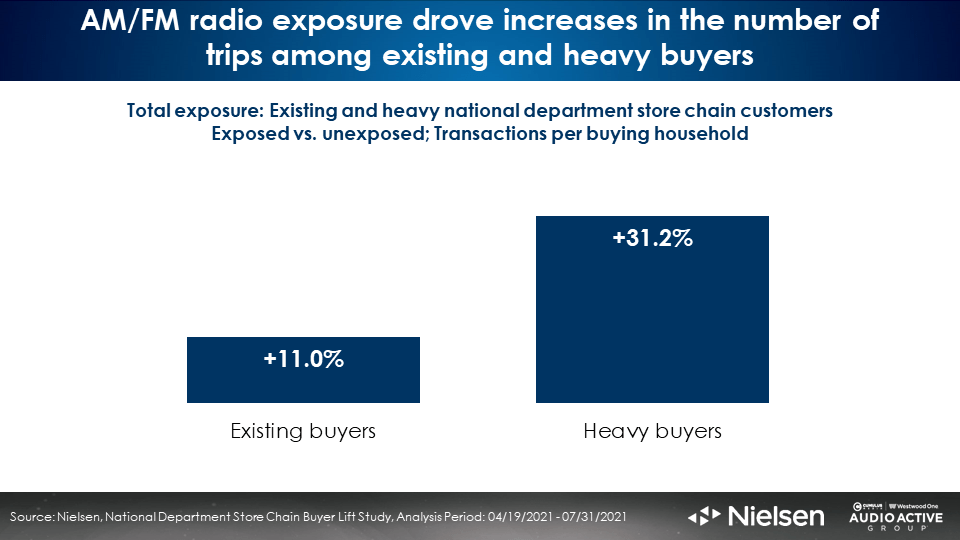
The AM/FM radio campaign caused the retailer’s share of category spend to surge +15% and increased total sales by +10%
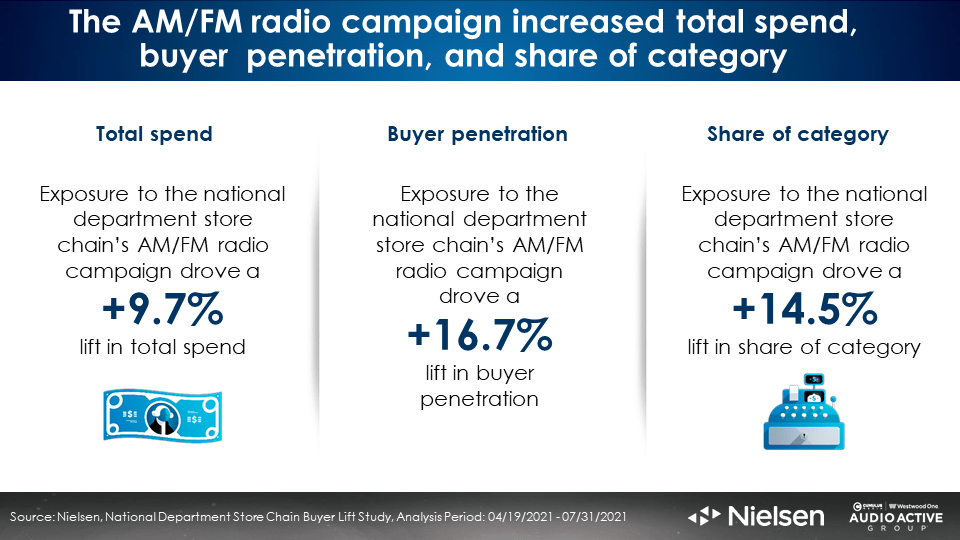
For every dollar spent on the AM/FM radio campaign, the national department store chain generated $13 of incremental sales, on par with Nielsen’s retail AM/FM radio return on advertising spend benchmarks
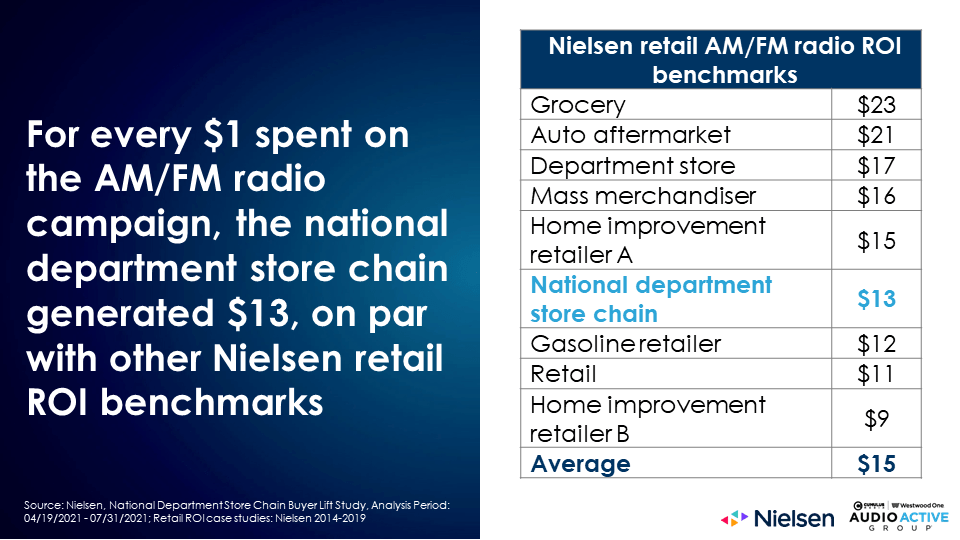
AM/FM radio mobilizes large groups of people to act
Did the pandemic dent AM/FM radio’s ability to generate sales effect? Not in the least. This brand-new Nielsen study revealed AM/FM radio generates large lifts in customer base, total spend, and share of category.
Reach is the foundation of marketing effectiveness. As America’s number one mass reach media, AM/FM radio generates significant sales effect for advertisers.
“This [pandemic] crisis will change the [advertising] industry by reminding us to focus on what we do best and what matters,” said Charlie Rudd, CEO of Leo Burnett London. He might have thinking of AM/FM radio when he continued, “We build businesses by creating large customer numbers keen to buy into what a brand offers. We mobilize and persuade large groups of people to act.”
Key takeaways:
- Light exposure to the campaign generated an eye popping +22% increase in the retailer’s customer base
- Different seasonal messages delivered strong lifts in customer base and total sales growth
- Exposure to the AM/FM radio campaign drove significant lifts in buying transactions, especially among heavy shoppers
- The AM/FM radio campaign caused the retailer’s share of category spend to surge +15% and increased total sales by +10%
- For every dollar spent on the AM/FM radio campaign, the national department store chain generated $13 of incremental sales, on par with Nielsen’s retail AM/FM radio return on advertising spend benchmarks
Click here to view an 11-minute video of the key findings.
Pierre Bouvard is Chief Insights Officer at Cumulus Media | Westwood One and President of the Cumulus Media | Westwood One Audio Active Group®.
Contact the Insights team at CorpMarketing@westwoodone.com.